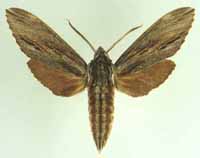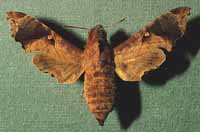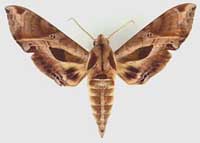|
|
Inspired and dedicated as per personal communication with Jodi Willis, October 7, 2010; October 10, 2010
Updated as per James P. Tuttle's The Hawk Moths of North America, October 10, 2010
Updated as per Butterflies and Moths of North America, formerly USGS, October 10, 2010
|
Lowndes County, Georgia
Sphingidae
For care of "found larvae/caterpillars" visit Manduca sexta larva, central Texas, August 21, 2008, Trina Woodall.
This page is inspired by and dedicated to
Jodi Willis and her class of Second Grade students, who
submitted the Xylophanes tersa
caterpillar find in Lowndes County Georgia. It is great to see teachers making the extra effort to inspire and educate their students.
Many thanks to the students, also, who reported the larva to their teacher. Hope they have success.
Jodi writes, October 7, 2010, "My name is Jodi and I teach second grade in South Georgia. Some of our students found a Tersa Sphinx caterpillar at the
school today. We would love to see it go through all the stages and become a moth. The problem I have is that I do not know what to feed it, or what
kind of habitat I need to keep it in to allow it to grow and thrive. Could you please help me. I saw some pictures of various stages online. Some of the
caterpillars were green and some were brown. Ours is brown. The spots are very defined. I look forward to hearing from you soon."
I reply, "Here is URL for a larval thumbnail page for Escambia County, Florida. The larvae you are likely to encounter in your area of
Georgia are probably pretty much the same.
http://www..silkmoths.bizland.com/flEscambiasphlar.htm
Some food plants are listed with the tersa thumbnail, and additional ones can be seen by clicking on the tersa link to visit the species file.
Also near top of the page listed above is a link to care of found larvae. The same procedures can be followed with your larva.
"Best of luck with your project. I am retired now, but taught school for 32 years.
"If you can send me a digital picture of your tersa caterpillar and let me know your Georgia county, I will create a similar page for you and the
students."
Jodi writes, "Thank you so much for contacting me. I have put the larva in an airtight jar along with some food plants. He does not seem to be too
interested in eating. I don't know if he just does not like what I've gotten for him or if he is about to pupate. I did find him burrowed under
the dead grass that was in the container housing him. We used the dead grass because that is where he was found. I've tried 2 different kinds of food
and he has not eaten anything. I do not see white spots, so hopefully we don't have a fungus or wasp eggs or whatever happens to them. He still wiggles
when I touch him.
"We are located in Lowndes County, right on the Florida border. Still pretty warm here. Hopefully he will go through all the stages before winter.
"Thanks again for your time. Hopefully I'll be able to give my 2nd graders a science experience they will never forget."
I reply, "I suggest you remove the dead grass. In an airtight container, the decomposing grass will give off gases that might smother
the larva. That is why, when it is ready to pupate, and it is based on where you found it, that I recommend in the article about care of found larvae
that you put it in a pupation tub with just a paper towel, no foliage or grasses or anything else that will decompose.
"On Monday I will work on the website for Lowndes County.
"Larvae need very little oxygen at this time, and it should still be fine, but I recommend you remove the grasses."
Jodi clarifies, October 13, 2010, "Well, we are doing something right!! "Dottie" began to pupate last night. I guess that's why she would not eat. The kids were so excited. About how
long will we have to wait before we see a moth? I have no idea how long each stage lasts. I would like to ask also that you include 3rd grade in our
website. The teachers there are Mrs. Bice and Mrs. Reams. They are as excited about this as well and it was actually their class that found the
caterpillar. Again, thanks again for your help. I will try to take a picture and get it to you so you can add those. Talk to you again soon."
I reply, "Congratulations. If you had found "Dottie" in June, I would have predicted the moth would emerge within two to three weeks of
pupation, within as few as nine days if your weather was really warm and humid. If, in your area, you still have two months of warm weather, enough time
for another brood, then you will likely see a moth within two to three weeks. Be sure to reread the article linked from top of this page about an emergence container so the moth can
climb and hang when it first breaks forth from the pupal shell. This is very important so that the wings can inflate properly.
"Since you have found the caterpillar so late in the season, it is possible that this pupa will overwinter and not yield a moth until spring.
In southern Florida and southern Louisiana there have been flights of Xylophanes tersa recorded as late as November, but you may be too far north
for that to happen. The larvae have a remarkable ability to take cues from the environment (length of photo period, temperatures, possibly foodplant
quality) to determine whether or not they will produce the enzyme to put them in a state of diapause (hibernation) during the cooler months.
If "Dottie" produced the overwintering enzyme, then she would probably not emerge until the natural photo period again begins to increase. It is also
going to be hard to predict because the larva and pupa
have been and are experiencing extra artificial light and warmth.
"Use a storage emergence container that will maintain a high relative humidity while you are waiting. You may or may not have a long wait."
Thirty-six Sphingidae species are listed for Georgia on the U.S.G.S.
website. Not all of the species are reported or anticipated in
Lowndes County (No species are reported on U.S.G.S. as of October 10, 2010). It is hoped
that this checklist, with the thumbnails and notes, will help you
quickly identify the Sphingidae adult moths you are likely to encounter.
A "WO" after the species name indicates that
I have no confirmed reports of this species in Lowndes County, but I
(William Oehlke) expect that this moth and its larvae are present or
might be present.
Please note the above comments are not intended as a criticism of the USGS website. Their mandate is documented accuracy.
My goal is to assist people in identifying what they are likely to find. The USGS website has proven to be a great resource in that
undertaking, and I use it, sightings submitted by others, and James Tuttle's book to make interpolations.
A "USGS"
indicates the moth is reported on the USGS website and/or in
Lepidoptera of North America, #1. Distribution of Silkmoths (Saturniidae) and Hawkmoths (Sphingidae)
of Eastern North America,
an excellent little booklet available through Paul Opler.
Please help me develop this list with improved, documented accuracy
by sending sightings (species, date, location), preferably with an
electronic image, via email to
Bill Oehlke.
The night-blooming moon flower will attract many
Sphingidae at dusk and into the night.
Sphinginae subfamily
Sphingini tribe:
 |
This species is a strong migrant and adults nectar from
deep-throated flowers including moonflower (Calonyction aculeatum),
morning glory (Convolvulus), honey suckle (Lonicera)
and petunia (Petunia species).
|
 |
Ceratomia amyntor
WO,
the Elm Sphinx or Four-horned Sphinx
The upperside of the forewing is brown with dark brown and white markings including a white costal area near the wing base, dark streaks along the veins,
and a white spot in the cell.
Larvae feed on Elm (Ulmus), birch (Betula), basswood (Tilia), and
cherry (Prunus). |
 |
The upperside of the forewing is yellowish brown with no white markings, but there are indistinct black lines and dashes. The cell spot is gray with a black outline. The larvae feed in large groups and are much more
spectacular than the moths.
Catalpa is the larval host. |
 |
The upperside of the forewing is pale brownish gray with wavy black
and white lines and a black-outlined white cell spot. The upperside
of the hindwing is gray with diffuse darker bands. |
 |
The upperside of the forewing is dark brown with a dusting of white
scales. Some moths have patches of reddish or yellowish brown on the
wings.
|
 |
Isoparce cupressi
WO, the Cypress or Baldcypress Sphinx
Isoparce cupressi, the rare Cypress Sphinx, flies in Cypress swamps in Georgia (specimen type locality), and from Maryland to Texas.
It has been reported in Mexico. possibility
|
 |
The upperside is of the forewing is gray with two
(sometimes one or three) black dashes near the wing center;
other markings are usually diffuse. The upperside of the hindwing is
a uniform brown-gray.
If you've got pines, this species is likely present.
|
 |
The upperside of forewing is gray to grayish brown with a black line
running from the middle of the costa to the middle of the outer
margin; the line may be broken near the margin. There is a splash of
brown around the cell spot.
|
 |
I suspect if you grow tomatoes, you are likely to encounter Manduca quinquemaculata.
|
 |
Look for three large yellow spots
on each side of the abdomen. The upperside of the forewing is
yellowish brown to deep chocolate brown with a dusting of white
scales and zigzagged black and white lines.
|
 |
If you grow tomatoes, you have probably encountered Manduca sexta
in the larval stage.
Larvae get very large and can strip a tomato plant.
|
 | The upperside of the forewing is gray with indistinct black and
white markings. There is a series of black dashes
from the base to the tip, and a small white cell spot.
|
Smerinthini Tribe:
 |
The adults are also highly variable; sometimes wings of an individual
may be all one color or may have several colors, ranging from pale to
dark brown, and may have a white or pink tinge. Patterns range from
faint to pronounced.
See the file for the female; she is different. |
 |
Paonias astylus flies from March-September in Florida and from
April-September in Louisiana. There is one brood northward from
June-August.
This appears to be an uncommon species.
|
 |
Named for the dull grey-blue spot (minus dark pupil) in the hindwing,
this moth has a wide distribution in the eastern United States.
I regularly see them on Prince Edward Island, and they are reported
as far south as Florida.
|
 |
Named for the small eye-spot in the hindwing, this moth has a wide
distribution and is probably common in Wakulla County.
I regularly see them on Prince Edward Island, and they are reported
as far south as Florida.
|
 |
This moth is widely distributed and fairly common.
Along the East Coast, it flies from P.E.I. to Florida.
|
Macroglossinae subfamily
Dilophonotini tribe:

|
The body and wings are dark brown. The forewing has a large black
patch covering most of the outer half of the wing. There is a pale
tan cell spot (dark inner pupil), and a fairly straight median line
to the inside of the cell spot.
|
 |
During the night adults nectar at flowers, including bouncing bet
(Saponaria officinalis) and Asystasia gangetica beginning at dusk.
July and August are flight times in the southern states. adult stray
|
See Hemaris comparison to help distinguish
the next three species.
 |
Hemaris gracilis
WO, the
Slender Clearwing or Graceful Clearwing
This day-flying moth is less common and has not been recorded in
Bibb County, but it may be present. unlikely
|
 |
Hemaris thysbe
WO, the Hummingbird Clearwing
It is not difficult to see why many gardeners would mistake an
Hemaris thysbe moth for a small hummingbird as it hovers,
sipping nectar from flowers through a long feeding tube.
|
 |
Hemaris diffinis
WO, the
Snowberry Clearwing or Bumblebee Moth
Adults mimic bumblebees and are quite variable. The wings are basically clear, with dark brown to
brownish-orange veins, bases and edges. The thorax is golden-brown to
dark greenish-brown. The abdomen tends to be dark (black) with 1-2
yellow segments before the tip.
|
Philampelini tribe:
 |
Larvae get large and feed on grape vines and Virginia creeper.
Note the differences between this moth and the Pandorus Sphinx. |
 |
Eumorpha fasciatus
WO, the Banded Sphinx
The upperside of the moth is dark pinkish brown. Each forewing has a
lighter brown band along the costa, and sharp pinkish white bands and
streaks. Larvae feed upon primrose-willow, Ludwigia (water primrose)
and other plants in the evening primrose family.
|
 |
Eumorpha intermedia
WO, the Intermediate Sphinx
The Intermediate Sphinx Moth, (Eumorpha intermedia), (Wing span: 3 9/16 - 3 7/8 inches (9 - 9.8 cm)), flies in lower austral and subtropical lowlands in North Carolina,
Florida, Georgia,
Mississippi, Louisiana, and South Texas.
|
 |
If you have Grape or Virginia Creeper nearby, then you probably have
this species.
I often get asked to identify larvae from areas not
previously reported. |
Macroglossini tribe:
 |
This day flier is widely distributed. If you have Virginia Creeper, you
probably have the Nessus Sphinx. Two bright, distinct, narrow yellow
bands are often visible on the abdomen.
|
 |
The lower wings of this hawkmoth are a solid brownish-orange,
matching the body colour.
You will often see this species listed as Darapsa pholus,
especially in older literature.
|
 |
Darapsa myron
WO, the Virginia Creeper Sphinx or the Grapevine Sphinx
If you have the
foodplants indicated in the common names, you probably have this
species nearby. The lower wings are orange.
|
 |
If you have hydrangea growing near a stream, then you might have the
Hydrangea Sphinx.
|
 |
The moth's outer margin of the forewing is deeply scalloped.
The upperside is light brown with dark brown markings.
There is a small black and white spot near the tip.
Grape (Vitis), ampelopsis (Ampelopsis), and Virginia creeper
(Parthenocissus) all serve as larval hosts.
|
 |
Hyles lineata
WO, the White-lined Sphinx
This species has
strong migrating tendancies from much further south.
There are records from New Hampshire and Maine. |
 |
This moth is very much under reported across the United States. It
is a rapid day flier so is probably not in too many collections.
Grape is a popular larval host.
|
 |
This moth is much more common to the south. It is a strong migrant,
however, and is probably well established in Bibb County.
|
Xylophanes tersa larva, October 7, 2010, Jodi Willis; Second Grade class; Mrs. Bice and Mrs. Reams; Third Grade class
|
|
Use your browser "Back" button to return to the previous page.
This page is brought to you by
Bill Oehlke and the
WLSS. Pages are on space rented from Bizland. If you would like
to become a "Patron of the Sphingidae Site", contact Bill.
Please send sightings/images to Bill. I will do my best to respond to
requests for identification help.
 | 
Show appreciation for this site by clicking on flashing butterfly to the left.
The link will take you to a page with links to many insect sites. |
